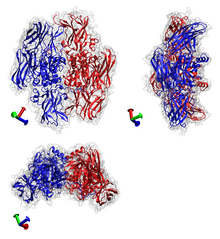| Transglutaminase | |||||||||
|---|---|---|---|---|---|---|---|---|---|
 Transglutaminase example: coagulation factor XIII from human blood. PDB code: 1EVU. | |||||||||
| Identifiers | |||||||||
| EC no. | 2.3.2.13 | ||||||||
| CAS no. | 80146-85-6 | ||||||||
| Databases | |||||||||
| IntEnz | IntEnz view | ||||||||
| BRENDA | BRENDA entry | ||||||||
| ExPASy | NiceZyme view | ||||||||
| KEGG | KEGG entry | ||||||||
| MetaCyc | metabolic pathway | ||||||||
| PRIAM | profile | ||||||||
| PDB structures | RCSB PDB PDBe PDBsum | ||||||||
| |||||||||
Transglutaminases are enzymes that in nature primarily catalyze the formation of an isopeptide bond between γ-carboxamide groups ( -(C=O)NH2 ) of glutamine residue side chains and the ε-amino groups ( -NH2 ) of lysine residue side chains with subsequent release of ammonia ( NH3 ). Lysine and glutamine residues must be bound to a peptide or a protein so that this cross-linking (between separate molecules) or intramolecular (within the same molecule) reaction can happen.[1] Bonds formed by transglutaminase exhibit high resistance to proteolytic degradation (proteolysis).[2] The reaction is[1]
- Gln-(C=O)NH2 + NH2-Lys → Gln-(C=O)NH-Lys + NH3
Transglutaminases can also join a primary amine ( RNH2 ) to the side chain carboxyamide group of a protein/peptide bound glutamine residue thus forming an isopeptide bond[1]
- Gln-(C=O)NH2 + RNH2 → Gln-(C=O)NHR + NH3
These enzymes can also deamidate glutamine residues to glutamic acid residues in the presence of water[1]
- Gln-(C=O)NH2 + H2O → Gln-COOH + NH3
Transglutaminase isolated from Streptomyces mobaraensis -bacteria for example, is a calcium-independent enzyme. Mammalian transglutaminases among other transglutaminases require Ca2+ ions as a cofactor.[1]
Transglutaminases were first described in 1959.[3] The exact biochemical activity of transglutaminases was discovered in blood coagulation protein factor XIII in 1968.[4]
- ^ a b c d e DeJong GA, Koppelman SJ (2002). "Transglutaminase Catalyzed Reactions: Impact on Food Applications". Journal of Food Science. 67 (8): 2798–2806. doi:10.1111/j.1365-2621.2002.tb08819.x.
- ^ Cite error: The named reference
Griffinwas invoked but never defined (see the help page). - ^ Clarke DD, Mycek MJ, Neidle A, Waelsch H (1959). "The incorporation of amines into proteins". Arch Biochem Biophys. 79: 338–354. doi:10.1016/0003-9861(59)90413-8.
- ^ Pisano JJ, Finlayson JS, Peyton MP (May 1968). "[Cross-link in fibrin polymerized by factor 13: epsilon-(gamma-glutamyl)lysine]". Science. 160 (3830): 892–3. Bibcode:1968Sci...160..892P. doi:10.1126/science.160.3830.892. PMID 4967475. S2CID 95459438.